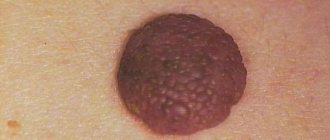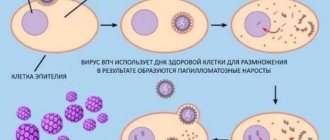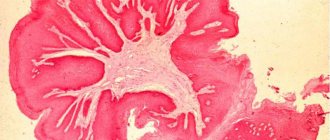Many people do not know when they hear about the diagnosis of HPV type 33 in women, what is it? Papillomavirus 33 strains are included in the dangerous group. If it is not treated promptly, there is a high risk of developing a cancerous tumor. The problem is that diagnosis is difficult; moreover, this virus is almost impossible to completely remove from the body. The infection manifests itself and progresses mainly in women. Men are its carriers, since their immunity more often suppresses the virus.
What is papillomavirus type 33
HPV 33 is an infectious pathology in women, which is included in the group of high oncogenic risk. When it comes into contact with the skin, the virus destroys the structure of healthy cells, causing the appearance of genital warts and papillomas on certain parts of the body. For women, the virus is dangerous because it leads to the development of serious gynecological diseases, in particular cervical cancer, which is preceded by an erosive process and dysplasia. HPV genotype 33 is a very dangerous strain. If it is detected in the body, regular examination is strictly indicated.
Virus type 33: routes of infection, diagnosis and therapy
The HPV 33 virus is highly oncogenic. This means that when immunity declines, cancer can develop. If a person is diagnosed with papillomavirus thirty-three, he should consult a doctor. HPV type 33 is expressed on the body in the form of papillomas and condylomas; they form on the vagina in women and on the penis in men.
Type 33 is the most dangerous for females. HPV 33 provokes erosion, inflammation, and if the pathological condition is not treated, then there is a high probability of developing a malignant tumor of the cervix.
HPV type 33 affects men extremely rarely. If the doctor suspects HPV 33, he prescribes a detailed diagnosis. During diagnosis, the question of the appropriateness of therapy is decided.
Typically, patients are prescribed PCR analysis, colposcopy, smear and oncocytology. If the load is not heavy, then healing can occur on its own; usually the process lasts 3 years. If you have been diagnosed with the HPV 33 virus, the main thing is not to panic and not self-medicate.
Signs of the disease
When entering a woman’s body, papillomavirus type 33 promotes the formation of papillomas on the genitals. They are usually discovered during a gynecological examination. Locations of papillomas:
- Cervix;
- vaginal mucosa;
- labia
Visually, the formations provoked by virus 33 are represented by small genital warts, their base is a wide stalk. A characteristic difference is uneven edges.
The presence of human papillomavirus type 33 is indicated by the manifestation of a disease such as cervical intraepithelial neoplasia. This is nothing more than the precancerous stage of the cervix in women. Neoplasia develops in 3 stages, the last of which in medicine is considered to be the beginning of oncology.
Papillomavirus type 33 in men is manifested by anogenital warts, which most often grow on the penis, less often they appear on other parts of the body. For representatives of the stronger sex, this virus does not pose a great danger, since it does not cause cancer in them. It is extremely rare to develop Bowen's disease, bowenoid papulosis.
The latter disease also occurs in women and is represented by the development of papillomas on the genitals, rising above the skin. The reason for such growths is weakened immunity, as a result of which HPV strain 33 is activated. In men, velvety weeping plaques are formed, which are large in size and have clear boundaries.
What is HPV type 33 in women? This is a dangerous signal indicating the need for immediate examination and comprehensive treatment.
What is HPV, how does it enter the body, what pathologies are provoked by HPV
Chronic human papillomavirus includes more than 70 types of HPV. Different types of virus cause different pathologies. Some types cause the formation of genital warts, others – sexual pathologies, and still others – cancer.
Each human papillomavirus has its own number; one type differs from another in DNA. To date, it has been proven that human papillomavirus types 16 and 18 can provoke cancer of the throat, penis in men, and cervix in women.
HPV is included in the group of diseases that are transmitted during sexual intercourse. The virus can also be transmitted from a sick mother to a child during childbirth. The risk of infection is higher in the following categories of people:
- People who begin to be sexually active early.
- People who often change sex partners.
- People who frequently engage in anal sex.
- People with weak immune systems, such as people who are HIV positive, have had a serious illness, are taking medications to suppress the immune system, or have diabetes.
- People with sexually transmitted infections caused, for example, by chlamydia or other microbes.
- A number of women who often have abortions.
What pathologies can be caused by HPV? The human papillomavirus can cause the following groups of pathologies:
- Types 1, 2, 3, 4 cause the formation of painful warts on the surface of the body and genitals.
- Types 6, 11 provoke the formation of genital warts. Typically, condylomas affect the mucous membrane of the mouth, penis, and vagina in women. Sometimes growths can appear on the bladder, urethra and cervix in women.
- HPV 33, type 31 causes bowenoid papulosis. The same disease is provoked by HPV 16, 18. The pathology is characterized by a rash on the skin of the vagina in women and on the penis in men.
Rashes caused by HPV 33, 31, 16, 18 resemble non-bulging plaques. These plaques are located under the skin and can be yellow, pinkish, or whitish in color.
Bowenoid papulosis can lead to skin cancer. HPV 16, 18 can cause Bowen's disease, which can lead to cancer of the male genital organs.
How is papillomavirus transmitted?
HPV 33 is easily transmitted from an infected person to a healthy person. It is worth noting that the carrier of the virus may not have any signs of disease, but he is an active carrier of unsafe bacteria. It is customary to distinguish 3 methods of transmission of the virus:
- Sexual intercourse without using contraception. HPV type 33 in men persists for a long time on the foreskin. This is the reason for the frequent infection of women.
- Contact-household route, when a healthy person uses the personal belongings of a virus carrier and public goods. Microtraumas on the skin contribute to rapid infection.
- During passage through the birth canal, a child can become infected with HPV 33 from the mother. Infection of a woman and a newborn baby can occur during a caesarean section, for which unsterile instruments were used.
When this type of human papillomavirus enters the skin and blood, it can immediately become active in people with weak immunity or remain asymptomatic.
Transmission routes
Human papillomavirus infection is transmitted through direct contact from one person to another. It is very difficult to avoid infection, since no one can say for sure who in the environment is a carrier of HPV and who is healthy.
Doctors identify 3 main routes of transmission of a viral infection that causes papillomas to appear on the mucous membranes and skin:
- Sexual . Most often, the infection is transmitted during intimacy, when the couple does not use protection. Infection occurs during vaginal, oral and anal sex. Therefore, after infection, papillomas can appear not only in the genital area, but also in the oral cavity and rectum;
- Contact and household . The pathogen is transmitted during the use of a personal item of a virus carrier. For infection to occur, a healthy person must have at least minor damage on the body, for example, microscopic wounds. It is through them that the infection enters the body;
- Generic . A baby can become infected naturally from its mother during birth. There is a possibility of transmission of the virus during a caesarean section if surgical instruments were not sufficiently disinfected.
The activation of type 33 virus, which has already managed to penetrate the body, causes a weakening of the immune system. This can happen for various reasons, for example, due to hormonal imbalances or prolonged stress.
Symptoms At the initial stages of development, HPV 33 strain does not reveal itself. Therefore, it is almost impossible to suspect an infection. In best cases, the pathogen will remain dormant for the next few years after entering the human body.
In a woman or man with a weakened immune system, the virus appears 2-4 months after infection. It is at this moment that the first papillomas begin to form on the body.
In the fairer sex, rashes often affect the area of the labia minora, vaginal walls and cervix. Therefore, only a gynecologist can identify them during the next examination.
Human papillomavirus infection type 33 goes through 3 stages of development. The first 2 are relatively safe for health. Stage 3 can easily lead to an oncological process in the area that was attacked by the virus.
In women, symptoms of human papillomavirus 33 strains are limited to the following conditions:
- Pain and feeling of severe discomfort in the lower abdomen;
- Unnatural discharge containing blood;
- Pain during sexual intercourse.
Often men have no external signs of papillomavirus infection. Therefore, most of them are unaware that they are carriers of this disease. However, sometimes the infection provokes the formation of peculiar warts on the body on different parts of the body.
Men infected with type 33 virus may notice papillomas in the following areas:
- Anus;
- Sexual organ;
- Groin area;
- Rib cage;
- Armpits;
- Neck and Eyelids.
For men, this pathogen does not pose any particular danger. Only rarely do such rashes lead to cancer.
What are the risks for the carrier of the infection?
Human HPV type 33 is considered the most dangerous strain of the virus; it is the causative agent of cancer. In most cases, the risk group includes women whose papillomavirus progresses on the genitals.
The resulting papillomas are often injured, causing discomfort to the woman; they are a source for other gynecological infections. If timely measures are not taken and the problematic tumor is not treated, it can cause cancer.
How does the human papillomavirus affect pregnancy?
Pregnancy and HPV 33 are combinations that are often encountered in practice. When carrying a child, hormonal changes occur in a woman’s body, causing the immune system to suffer. At this moment, the “sleeping” virus is activated. For a pregnant child, HPV 33 is not a direct threat. But the progressive papillomavirus depresses a woman’s health.
With a strong decrease in the body's protective functions, an oncological disease provoked by a virus can develop. Therefore, when the first neoplasms are detected, it is necessary to undergo an examination and, through histological analysis, determine the cause of the appearance of papillomas.
If a woman is confirmed to have HPV 33, she is allowed to bear and give birth to a child. The main thing is to always remain under the supervision of a specialist.
There is a real danger for a woman if papillomas have formed in the vagina. During childbirth, they can be injured, bleed and “pick up” new infections, at the same time infecting the baby during natural childbirth.
Oncogenicity
HPV 33 is a strain of the virus that is included in the oncogenic risk group. Being present and developing in a woman’s body, under favorable conditions it contributes to the transformation of harmless papillomas into malignant tumors.
If we compare this papilloma virus with other types, it is more often than others the cause of oncology. In an advanced form, papillomas present on the structures of a woman’s reproductive system can lead to the formation of cervical cancer.
Diagnostics
Most people live and have no idea that they are infected with the human papillomavirus. Often the pathogen is identified at the stage of examination. There are several methods for identifying the virus:
- A simple gynecological examination will help identify formations. Patients do not notice the growths. They are localized in hard-to-reach places and do not manifest themselves clinically. It is periodic visits to a gynecologist that can prevent dangerous diseases.
- A Pap smear is performed on all women. It shows the presence of normal and pathological cells in the vagina, urethra, and cervix. Using the study, inflammatory and dysplastic changes in the reproductive organs are determined.
- PCR is an expensive but highly sensitive diagnosis of HPV infection. Detects DNA and virus concentration in the blood.
- The digest test shows the type and number of oncopathogenic HPV strains. Can be performed simultaneously with cytological examination. A smear is taken from the vagina and urethra. The method shows the risk of infection. The study helps diagnose the disease at an early stage.
Symptoms and diagnosis of papillomavirus type 33
Symptoms of HPV type 33 in women against the background of the spread of infection are manifested by the following signs:
- Unnatural discharge from the genitals with bloody admixture and an unpleasant odor.
- During sexual intercourse, discomfort is felt, pain is felt due to damage to the warts.
- Periodic pain in the lower abdomen becomes frequent and more intense.
If such symptoms appear, it is necessary to be examined in the near future at a medical institution, where the disease will be diagnosed for the presence of HPV 33:
- Visual inspection by a specialist.
- Colposcopy is a detailed examination of the cervix in women who suspect the presence of a virus in the body. A special device allows the doctor to examine the organ in an enlarged form and conduct the necessary tests. The woman may feel slight discomfort.
- Cytological analysis. It consists of preliminary taking a scraping directly from the cervical canal and cervix. If HPV 33 is present in a woman’s body, the analysis will show this.
- The Digene test makes it possible to determine the HPV strain with maximum accuracy and determine the tendency to degenerate into cancer.
- The polymerase chain reaction method makes it possible to detect HPV type 33 DNA. A significant drawback of the method is that the result may not always be correct.
- During the biopsy, local anesthesia is used, and when examining the cervix, surface tissue is collected for examination. Such an analysis helps to establish an accurate diagnosis and determine the degree of development of spread 33 in a woman.
If genital warts form in the form of condylomas, you should not neglect them, but immediately seek help. In addition, virus 33 papillomas can appear on the skin of the arms, legs and other parts of the body.
Therapy for viral infection
Today there is no specific clear line of therapy for HPV. What type of treatment the doctor will choose depends on many factors: the age of the patient, the progression of the virus, the type of HPV.
All treatment today is aimed at eliminating the rapid progression of the infection, and not at eliminating the virus from the body.
It is necessary to treat growths and papillomas on the arms and legs if they grow rapidly, hurt and are located in open areas. If the wart does not cause discomfort, then it is not necessary to remove it. Warts are removed mechanically, the most popular today are:
- cryotherapy;
- electrocoagulation;
- laser, etc.
HPV can be present in the body for many years and not manifest itself until conditions for progression become favorable. Doctors recommend using Epigen Intim spray to prevent the appearance of papillomas in intimate places. The spray is safe and has beneficial properties. It relieves inflammation, improves immunity, regenerates the skin, and blocks the proliferation of HPV in the cervix.
The main treatment for genital warts is removal. Among the most popular mechanical methods for removing condylomas are the following:
- Cryodestruction method. Removal is carried out using liquid nitrogen. The procedure is absolutely painless and leaves no traces after removal. If there are a lot of condylomas, they are removed in several procedures with an interval of a week.
- Method of radio wave coagulation. In this case, removal takes place using a special knife. The procedure is done under local anesthesia. It is a little painful, but it gives an excellent healing effect.
- Laser therapy. Laser removal is widely used, leaves no traces and is painless as it is performed under local anesthesia.
- Electrocoagulation method. Electrical removal is a painful method, but it gives an excellent effect.
- The method of surgical excision is practically not used today. It is recommended only in cases where the wart growths are very large or a cancerous tumor has already begun to develop.
- Removal can also be done using the medication Solcaderm. After a single application, the growth dies off.
- You can remove growths using various chemicals. Genital warts are treated with medicinal and herbal preparations, due to which the growths die off.
In addition to removal, antiviral therapy is mandatory. Medicines that stimulate the immune system must be prescribed. Human papillomavirus infection of all types, including HPV 33, is treated with the following medications:
- Inosiplex.
- Interferon.
- Amiksin.
- Cycloferon.
- Podophyllin.
- Condilin.
The above drugs have been proven to have a good therapeutic effect. However, no method guarantees 100% recovery. It is important to remember that when treating HPV 33 or another type of HPV, sexual intercourse should be temporarily avoided. After completing treatment, you must use a condom for six months.
Treatment of pathology
Papillomas existing on the body can be cured in several ways. In modern medicine, conservative therapy is used, based on taking medications to treat the virus, and removing growths mechanically. How to treat HPV 33 in women is determined by the doctor after a preliminary examination.
Conservative treatment
If HPV type 33 is detected at its first manifestations, specialists resort to complex treatment of the infection, which consists of:
- Taking special medications to enhance immunity, antiviral medications that suppress the proliferation of the papilloma virus.
- Removing emerging papillomas using ointments, gels or by cauterizing them.
If conservative therapy is chosen correctly, genital warts caused by a virus can be eliminated without surgery.
Folk remedies
Papillomavirus 33 is dangerous for women, but to maintain immunity and improve well-being, it is worth using traditional medicine. They can be taken while being treated with medications. How to treat HPV 33 in this way? Infusions and decoctions, teas prepared with fresh berries and dried herbs are useful.
Mechanical removal of growths
If a woman’s existing papillomas increase in size and threaten to become malignant, they must be removed using the following methods:
- Radio wave excision - the wart is removed with a special radio knife, local anesthesia is applied.
- Cryotherapy - removal of growths occurs under the influence of liquid nitrogen on them.
- Surgical removal when gentle methods have not shown a positive result.
- Laser therapy is used frequently. After it there is no relapse, there are no scars, which is important for women.
Treatment methods for women
Need advice from an experienced doctor?
Get a doctor's consultation online. Ask your question right now.
Ask a free question
There is no specific treatment for human papillomavirus infection. Antiviral, restorative, and symptomatic therapy is prescribed. If necessary, surgical intervention is performed. Therapeutic tactics are based on the results of the tests performed and the patient’s well-being. The main methods of treatment include:
Drugs
- Allokin-alpha affects the synthesis of interferons, which take part in the immune response. Prescribed for the treatment of patients with herpes infection, hepatitis B, papillomas. The medicine contains alloferon, which enhances the synthesis of interferon, improves recognition and lysis of defective cells by lymphocytes. Allokin-alpha does not cause teratogenic, allergic, or carcinogenic effects. The drug is used as monotherapy if the disease is not accompanied by clinical manifestations. The drug solution is administered subcutaneously. Before the injection, the medicine should be diluted in 1 ml of saline solution. Mixing several medications in one syringe is strictly prohibited. 1 mg Allokin-alpha is administered once every 2 days. The patient is treated with the drug for several weeks.
- Isoprinosine is an antiviral agent with immunomodulatory properties. The drug affects the maturation of T-lymphocytes. Additionally, it activates killer T-cells and increases the level of Ig G. The listed immune cells inhibit the growth and reproduction of viral agents. They help remove HPV from the body. Patients note a positive effect from treatment after 2-3 weeks. You should take 6 tablets 3 times a day.
- Gepon consists of amino acids. Increases the body's protective properties. The drug affects the synthesis of interferons and antibodies. The medicine prevents the proliferation of papillomaviruses. Used for local and systemic treatment of human papillomavirus infection. The medication is prescribed 1 tablet 3 times a day. Doctors note the positive effect of using applications with Gepon. The duration of therapy depends on the patient’s condition, the type of virus, and the strength of the immune system.
- Viferon is used for a complex effect on viral agents. Pharmacies provide several forms of the drug (ointments, gels, rectal suppositories). There are no Viferon tablets; they are not absorbed in the gastrointestinal tract. The medicine is applied every 12 hours.
- Solcoderm is a solution for external use. The medicine is applied to the affected area several times a day. After a couple of weeks, the papillomas disappear.
- A folk remedy is douching with decoctions of chamomile, lemon balm, and nettle.
Removal of papillomas
HPV type 33 is localized in women on the cervix, in the vagina; surgical treatment is carried out in the absence of effect from conservative therapy, the formation is significant in size.
Modern medicine provides many options for removing condylomas. These include:
- Surgical treatment - the doctor excises the growths using a scalpel.
- Cryodestruction is a procedure in which papillomas are treated with liquid nitrogen.
- Radio wave removal occurs using a radio wave scalpel. The instrument relieves the patient of growths without affecting healthy tissue.
- Laser therapy is carried out with a special laser - it cuts off formations and cauterizes small blood vessels. The method prevents inflammatory tissue changes, bleeding, and scarring.
- Cauterization with chemicals is an inexpensive and painless procedure. The doctor treats the pathological area with podophyllin, podofilox. Dry crusts form, which will disappear in a couple of days.
Prevention of human papillomavirus infection and its relapses
The key to health is a correct lifestyle. Simple actions will help prevent HPV 33 infection and its relapses, in particular, completely giving up bad habits that reduce immunity (smoking, alcohol). Basically, HPV infection occurs through unprotected sexual intercourse, therefore, the use of contraceptives is mandatory. It is not recommended to start sexual activity too early, since the risk of infection with the virus and the formation of genital warts increases significantly.
After removing an existing growth, a woman should undergo regular preventive examinations.
Precautions to take if you have a virus in your body
- Vaccination. Economically developed countries of the world (USA, Canada) vaccinate girls, young women and men aged 11-14 years. Cervarix serum is available in Russia and Ukraine.
- Early initiation of sexual activity increases the risk of contracting papillomavirus several times. Warn children about possible danger!
- Get medical checkups every year. Women need to have a Pap smear 1-2 times a year in order to promptly suspect the development of cancer. Gynecologists recommend that, if possible, every woman undergo digest testing.
- If unpleasant symptoms appear in the genital area, do not delay visiting a doctor.
- Avoid casual sex.
- Get rid of bad habits.
- Try to avoid stressful situations.
- Strengthen your body's defenses through a healthy lifestyle.
The article has been reviewed by the site editors
Methods for diagnosing human papillomavirus type 33
Diagnosis of HPV type 33 is carried out in several stages. Initially, an examination is carried out by a gynecologist. If suspicious changes are detected in the cervix, the woman is sent for a colposcopic examination. The mucous membrane on the genitals is stained with a special substance to accurately carry out the analysis. HPV is detected as follows:
- cytology. Taking a smear or scraping from the cervical canal gives results with 80% accuracy;
- biopsy;
- An immunological test allows you to analyze the structure of special proteins and the development of a dangerous virus;
- polymerase chain reaction method. The procedure determines the type of HPV in the body;
- Digene test. The modern method reveals the degree of oncogenicity.
If you take the medicine without a doctor's prescription, you can achieve negative results. The path to restoring health must be systemic. At the hospital, specialists will determine the rate of medication intake and select the optimal procedures. Reading information about the disease on forums will give you more confidence in your actions.
Treatment
Doctors have still not been able to develop a unified scheme according to which treatment for HPV type 33 in women and men should be carried out. The choice of therapeutic technique directly depends on the patient’s age, the degree of spread of the viral infection and its strain.
The principle of treatment of this disease in all cases is based on the need to quickly eliminate the progression of the pathology. After this, you can begin to suppress the infection itself.
Papillomavirus leads to the development of unpleasant rashes on the body. If they hurt and grow quickly, they need to be removed immediately.
For this purpose, there are various hardware methods for excision of papillomas:
- Laser therapy;
- Cryotherapy;
- Electrocoagulation.
Surgical excision has long lost its popularity. Therefore, this technique is used to remove papillomas only in extreme cases.
Typically, excision of the growth with a scalpel is recommended if the papilloma is large or a malignant tumor has already begun to develop in its place.
Doctors often practice removing small benign tumors using a chemical method. It involves the use of various compounds that have a detrimental effect on the growth cells.
Such drugs include Solcaderm. It allows you to get rid of the rash after the first application.
If a patient is diagnosed with strain 33 virus, the following medications will be recommended:
- "Amiksin";
- "Cycloferon";
- "Inosiplex";
- "Condilin";
- "Interferon";
- "Podophyllin."
The listed drugs give positive results in the treatment of human papillomavirus infections of various types. However, none of them can provide a 100% guarantee of obtaining the desired effect.
Diagnostics of education
It is much easier to diagnose human papillomavirus infection at the initial stage. With a visual examination, a professional specialist can determine the condition of the mucous surface where genital warts form. Women are examined using a speculum of the cervix and vagina. In men, the groin area and urethral mucosa are examined.
Another examination option is a microscopic examination. Anogethyl warts are covered with various substances. Smear cytology is performed to identify a specific type of virus.
In almost 85% of cases, such a study accurately reveals the diagnosis. Fluid cytology is performed to identify precancerous conditions.
A biopsy is only done if a specific piece of tissue needs to be diagnosed. If cancer is suspected, the doctor performs a biopsy and then makes an accurate diagnosis. Thanks to this method, it is possible to confirm or refute the diagnosis. Therefore, it is necessary to listen to the recommendations of a specialist and carry out the appropriate procedures.
The most accurate and modern way to identify a diagnosis is to take the Digene test. Diagnosing pathology using this method is very easy and simple. In this case, the type of virus is determined, as well as the degree of the disease. If the oncogenicity does not exceed the indicator, then drug treatment is prescribed. Many doctors prefer to remove genital warts surgically.
Treatment with folk remedies
Standard treatment for HPV 33 can be successfully supplemented with proven traditional medicine recipes, we are talking about tinctures and teas that strengthen the immune system.
Chamomile and honey. 2 tbsp. l. crushed dry chamomile (sold in any pharmacy) pour 0.5 liters. boiling water Leave for three hours, then filter through a sieve or cheesecloth. Drink the infusion warm, with the addition of 2 tablespoons of honey. Therapy must be completed within 14 days.
Important! Before using folk remedies, you should consult your doctor.
Preventive actions
As you already know, the disease often cannot be treated. After removing the growths on the affected areas, the formation of papillomas and warts occurs again. In order to avoid serious consequences and restore your health, doctors recommend giving up unprotected sex. According to experts, a condom does not particularly protect against infection with this viral infection. However, in this way it is possible to reduce the risk of HPV 33 entering the human body.
First of all, it is necessary to reduce the number of partners. It is recommended to have sexual intercourse with one partner. It is advisable to be sexually active after reaching eighteen years of age. Early sexual relationships are not recommended for teenagers, who may harm their health. The immune system is also weakened after abortion and childbirth. Therefore, during this period, women should be careful and attentive to such procedures.
Taking into account all the nuances and recommendations of specialists, you can reduce the risk of formation of growths in intimate places and on the surface of the skin. You should not use other people's bath accessories and wear poor-quality clothes. Therefore, it is advisable to learn all these recommendations and carry out appropriate preventive procedures to avoid serious consequences. Today, it is possible to prevent the development of even the most serious disease on our planet.










